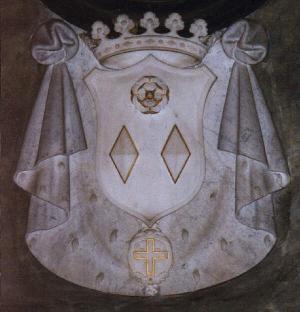 Arms
of the Santini family (azure two lozenges and a rose in chief or),
from Lucca.
Arms
of the Santini family (azure two lozenges and a rose in chief or),
from Lucca. Arms
of the Santini family (azure two lozenges and a rose in chief or),
from Lucca.
Arms
of the Santini family (azure two lozenges and a rose in chief or),
from Lucca.
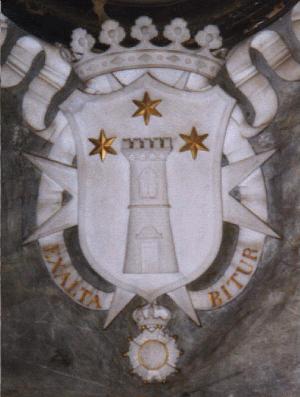 Arms
of the Torregiani family (Azure a tower between three stars of six points,
one in chief); the Santini heiress married a Torregiani in the early
19th c. From the family chapel at villa Camigliani, near Lucca.
Arms
of the Torregiani family (Azure a tower between three stars of six points,
one in chief); the Santini heiress married a Torregiani in the early
19th c. From the family chapel at villa Camigliani, near Lucca.
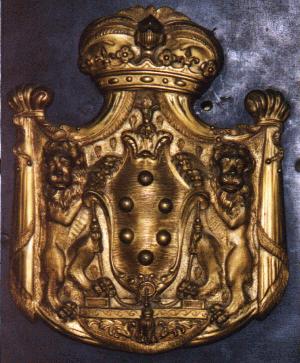 Arms
of the Mansi family (azure 8 balls or, an allusion to their function as
keepers of the mint dies in Republican Lucca). This display is on the door
of a 19th c. carriage. Note the mantling and crown.
Arms
of the Mansi family (azure 8 balls or, an allusion to their function as
keepers of the mint dies in Republican Lucca). This display is on the door
of a 19th c. carriage. Note the mantling and crown.
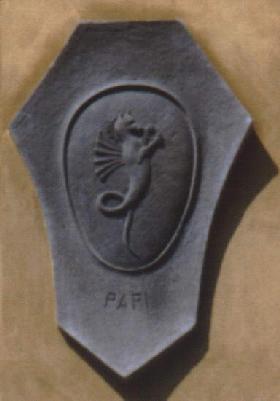 A
curious charge, on a wall near Santa Maria Corteorlandini, Lucca (Papi
family).
A
curious charge, on a wall near Santa Maria Corteorlandini, Lucca (Papi
family).
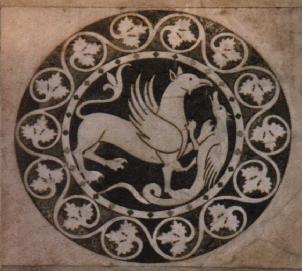 An
11th c. motif in inlaid marble on the facade of the Duomo, Lucca. It is
clearly Oriental in inspiration, yet it also points to heraldic griffons.
An
11th c. motif in inlaid marble on the facade of the Duomo, Lucca. It is
clearly Oriental in inspiration, yet it also points to heraldic griffons.
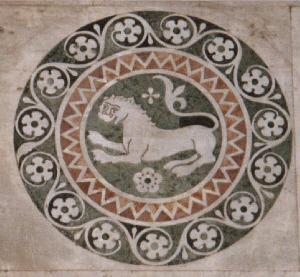 A 11th
c. lion: again, Oriental in appearance, but on its way to becoming a lion
rampant.
A 11th
c. lion: again, Oriental in appearance, but on its way to becoming a lion
rampant.
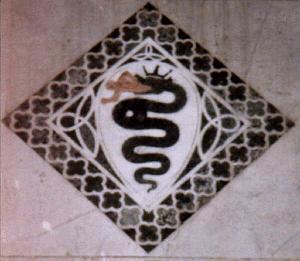 The
arms of Milan, from the same facade, but I'd date them to the 15th c.
The
arms of Milan, from the same facade, but I'd date them to the 15th c.
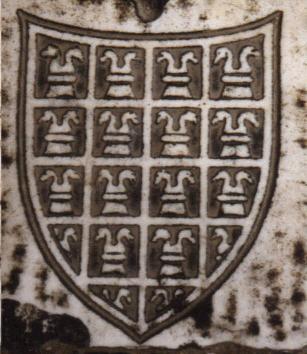 Interesting
arms of Sampanti, with a semy of rooks (1384) from the Campo Santo, Pisa.
Interesting
arms of Sampanti, with a semy of rooks (1384) from the Campo Santo, Pisa.
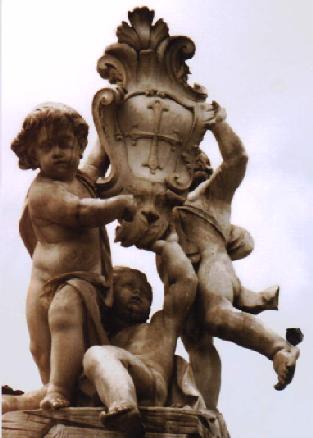 The
arms of Pisa held aloft by three putti, near the Campanile (leaning tower),
Pisa.
The
arms of Pisa held aloft by three putti, near the Campanile (leaning tower),
Pisa.
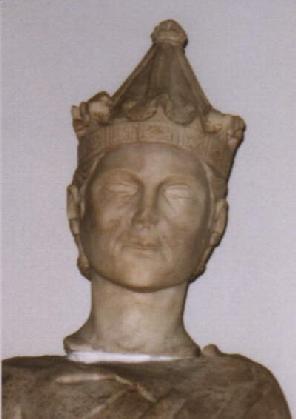 German
emperor's crown, from a sculpture for the tomb of Henry VII (d. 1313),
by Tino da Camaino. It struck me how different this crown looks from the
Modern version (Pisa, Museo del'Opera del Duomo).
German
emperor's crown, from a sculpture for the tomb of Henry VII (d. 1313),
by Tino da Camaino. It struck me how different this crown looks from the
Modern version (Pisa, Museo del'Opera del Duomo).
 Arms
of the Medici from the facade of S. Stefano Papa e Martiro, Pisa. Notice
the "capo di S. Stefano", also used by knights of the order (argent
a Maltese cross gules). The church was chosen in 1561 as the headquarters
of the Order of S. Stefano by its founder, Cosimo I de Medici.
Arms
of the Medici from the facade of S. Stefano Papa e Martiro, Pisa. Notice
the "capo di S. Stefano", also used by knights of the order (argent
a Maltese cross gules). The church was chosen in 1561 as the headquarters
of the Order of S. Stefano by its founder, Cosimo I de Medici.
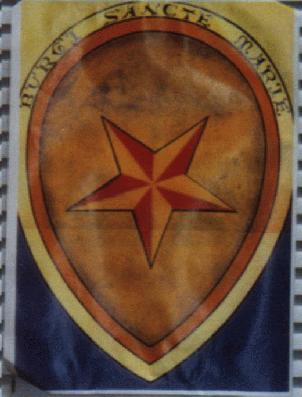 Curious
inverted star in the arms of a borgo (neighborhood) of Volterra. Many
small Tuscan towns are divided in borghi which have their own arms and
are often intense rivals in annual festivities (such as the famous Palio
in Siena).
Curious
inverted star in the arms of a borgo (neighborhood) of Volterra. Many
small Tuscan towns are divided in borghi which have their own arms and
are often intense rivals in annual festivities (such as the famous Palio
in Siena).
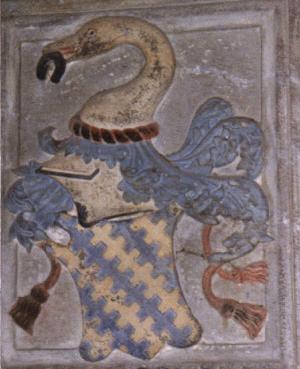 Interesting
color depiction of arms, 15th c., on the Palazzo dei Priori, Volterra: Antonio
di Leonardo Ferrucci, 1466 (bendy-embattled or and azure).
Interesting
color depiction of arms, 15th c., on the Palazzo dei Priori, Volterra: Antonio
di Leonardo Ferrucci, 1466 (bendy-embattled or and azure).
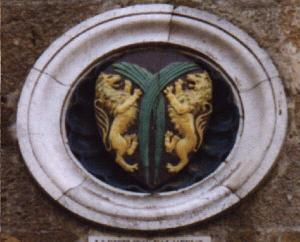 Another
common medium for heraldic displays is glazed earthenware, or maiolica,
here from the facade of the palazzo dei Priori, Volterra: canting
arms of Matteo Palmieri, 1474 (Gules two palms vert in saltire between
two lions affrontes or).
Another
common medium for heraldic displays is glazed earthenware, or maiolica,
here from the facade of the palazzo dei Priori, Volterra: canting
arms of Matteo Palmieri, 1474 (Gules two palms vert in saltire between
two lions affrontes or).
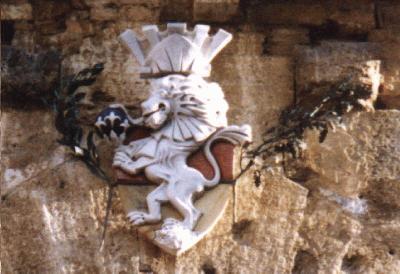 A modern
rendering of the arms of the town on San Gimignano, on the facade of the
communal palace. The arms are per fess Gules and Or, a lion argent overall
holding in its paw a ball azure charged with three fleurs-de-lys or. Note
how the oversized lion stretches out of the shield, and the mural crown
seems to sit on his head. The ball in the lion's hand changed tinctures
with shifting political alliegances.
A modern
rendering of the arms of the town on San Gimignano, on the facade of the
communal palace. The arms are per fess Gules and Or, a lion argent overall
holding in its paw a ball azure charged with three fleurs-de-lys or. Note
how the oversized lion stretches out of the shield, and the mural crown
seems to sit on his head. The ball in the lion's hand changed tinctures
with shifting political alliegances.
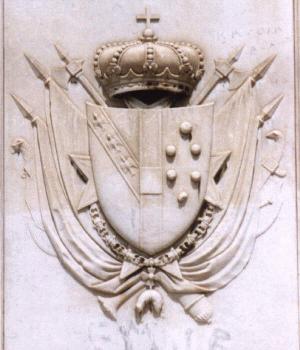 Habsburg-Lorraine
arms of Tuscany, from a 19th c. statue of Ferdinand III in Arezzo.
Habsburg-Lorraine
arms of Tuscany, from a 19th c. statue of Ferdinand III in Arezzo.
 Poster
announcing an unofficial referendum on Tuscan independence for May 25,
1997 (in imitation of a similar referendum called by the Liga Nord). Note
the use of the Habsburg-Lorraine flag in the lower right.
Poster
announcing an unofficial referendum on Tuscan independence for May 25,
1997 (in imitation of a similar referendum called by the Liga Nord). Note
the use of the Habsburg-Lorraine flag in the lower right.
 Arms
of Giorgio Vasari, from a ceiling in his house in Arezzo.
Arms
of Giorgio Vasari, from a ceiling in his house in Arezzo.
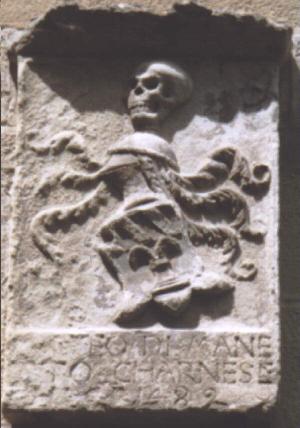 Unusual
crest, from the Palazzo Pretorio, Arezzo. Arms of Carnesecchi (dry meat!): Azure
a rook or and a chief bendy or and of the field (1482).
Unusual
crest, from the Palazzo Pretorio, Arezzo. Arms of Carnesecchi (dry meat!): Azure
a rook or and a chief bendy or and of the field (1482).
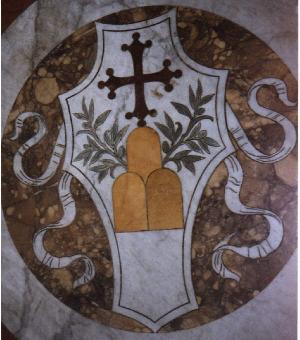 The
canting arms of the reformed Benedictine convent of Monte Oliveto Maggiore
(inlaid marble on the floor of the courtyard, famous for its frescoes by
Signorelli and Sodoma, early 16th c.).
The
canting arms of the reformed Benedictine convent of Monte Oliveto Maggiore
(inlaid marble on the floor of the courtyard, famous for its frescoes by
Signorelli and Sodoma, early 16th c.).
 Two
instances of the Florentine Albizzi's arms (sable two concentric annulets
or), Cortona, Palazzo Comunale.
Two
instances of the Florentine Albizzi's arms (sable two concentric annulets
or), Cortona, Palazzo Comunale.
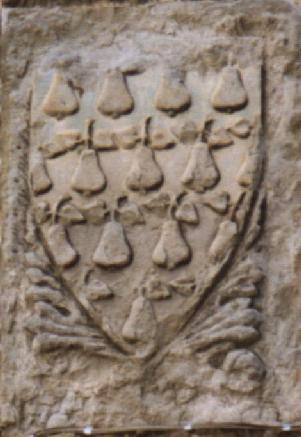 The
Peruzzi arms again, but in this 14th c. version it is a semy of pears.
Cortona, Palazzo Comunale.
The
Peruzzi arms again, but in this 14th c. version it is a semy of pears.
Cortona, Palazzo Comunale.
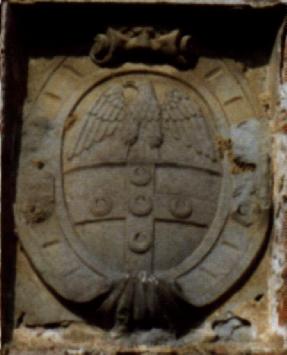 Arms
of the Piccolomini family (Argent on a cross azure five crescents or,
and a chief of the Empire), from the Locanda dell'Amorosa, once a villa
of theirs, now a delightful hotel 1 mile south of Sinalunga.
Arms
of the Piccolomini family (Argent on a cross azure five crescents or,
and a chief of the Empire), from the Locanda dell'Amorosa, once a villa
of theirs, now a delightful hotel 1 mile south of Sinalunga.
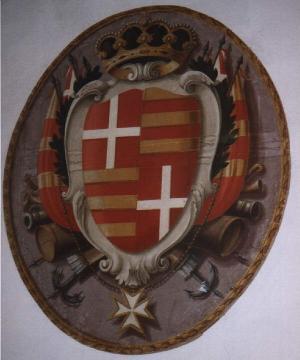 Arms
of Giuseppe Tommasi, Grand-Master of the Order of Malta 1803-05, from the
Museo Civico, Cortona.
Arms
of Giuseppe Tommasi, Grand-Master of the Order of Malta 1803-05, from the
Museo Civico, Cortona.
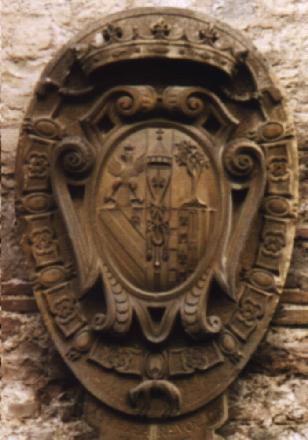 Arms
of the Della Rovere combined with the Montefeltre, early 16th c., ducal
palace in Gubbio.
Arms
of the Della Rovere combined with the Montefeltre, early 16th c., ducal
palace in Gubbio.
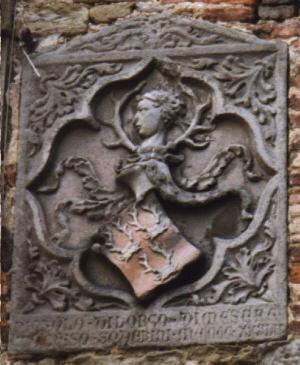 A
nice display of arms: Soderini (Gules three stag's attires argent),
Cortona, Palazzo Comunale, 1434.
A
nice display of arms: Soderini (Gules three stag's attires argent),
Cortona, Palazzo Comunale, 1434.